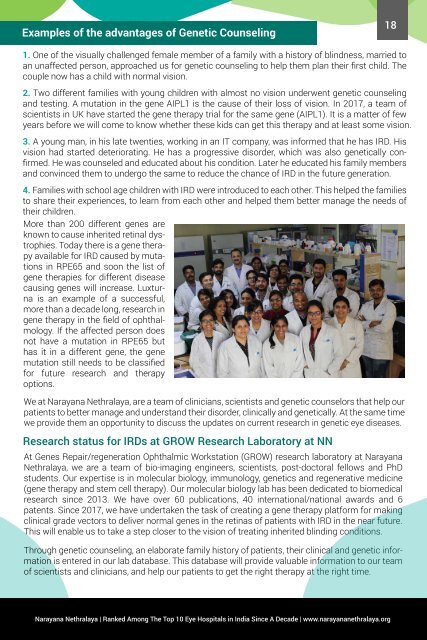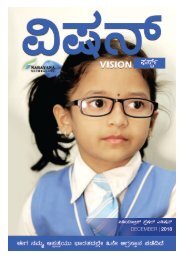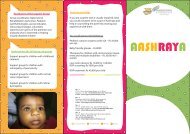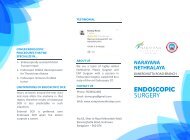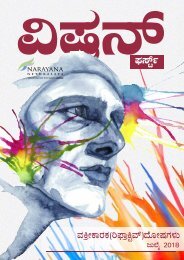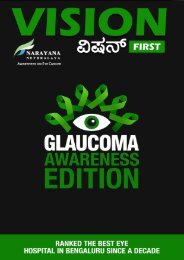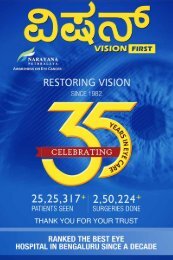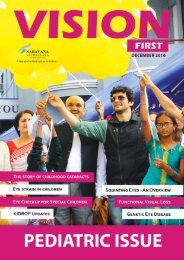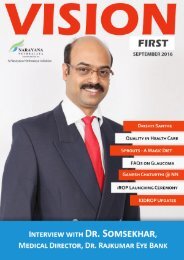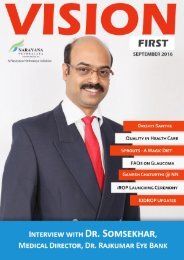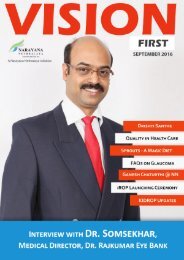Vision First English 2018
You also want an ePaper? Increase the reach of your titles
YUMPU automatically turns print PDFs into web optimized ePapers that Google loves.
Examples of the advantages of Genetic Counseling<br />
18<br />
1. One of the visually challenged female member of a family with a history of blindness, married to<br />
an unaffected person, approached us for genetic counseling to help them plan their first child. The<br />
couple now has a child with normal vision.<br />
2. Two different families with young children with almost no vision underwent genetic counseling<br />
and testing. A mutation in the gene AIPL1 is the cause of their loss of vision. In 2017, a team of<br />
scientists in UK have started the gene therapy trial for the same gene (AIPL1). It is a matter of few<br />
years before we will come to know whether these kids can get this therapy and at least some vision.<br />
3. A young man, in his late twenties, working in an IT company, was informed that he has IRD. His<br />
vision had started deteriorating. He has a progressive disorder, which was also genetically confirmed.<br />
He was counseled and educated about his condition. Later he educated his family members<br />
and convinced them to undergo the same to reduce the chance of IRD in the future generation.<br />
4. Families with school age children with IRD were introduced to each other. This helped the families<br />
to share their experiences, to learn from each other and helped them better manage the needs of<br />
their children.<br />
More than 200 different genes are<br />
known to cause inherited retinal dystrophies.<br />
Today there is a gene therapy<br />
available for IRD caused by mutations<br />
in RPE65 and soon the list of<br />
gene therapies for different disease<br />
causing genes will increase. Luxturna<br />
is an example of a successful,<br />
more than a decade long, research in<br />
gene therapy in the field of ophthalmology.<br />
If the affected person does<br />
not have a mutation in RPE65 but<br />
has it in a different gene, the gene<br />
mutation still needs to be classified<br />
for future research and therapy<br />
options.<br />
We at Narayana Nethralaya, are a team of clinicians, scientists and genetic counselors that help our<br />
patients to better manage and understand their disorder, clinically and genetically. At the same time<br />
we provide them an opportunity to discuss the updates on current research in genetic eye diseases.<br />
Research status for IRDs at GROW Research Laboratory at NN<br />
At Genes Repair/regeneration Ophthalmic Workstation (GROW) research laboratory at Narayana<br />
Nethralaya, we are a team of bio-imaging engineers, scientists, post-doctoral fellows and PhD<br />
students. Our expertise is in molecular biology, immunology, genetics and regenerative medicine<br />
(gene therapy and stem cell therapy). Our molecular biology lab has been dedicated to biomedical<br />
research since 2013. We have over 60 publications, 40 international/national awards and 6<br />
patents. Since 2017, we have undertaken the task of creating a gene therapy platform for making<br />
clinical grade vectors to deliver normal genes in the retinas of patients with IRD in the near future.<br />
This will enable us to take a step closer to the vision of treating inherited blinding conditions.<br />
Through genetic counseling, an elaborate family history of patients, their clinical and genetic information<br />
is entered in our lab database. This database will provide valuable information to our team<br />
of scientists and clinicians, and help our patients to get the right therapy at the right time.<br />
Narayana Nethralaya | Ranked Among The Top 10 Eye Hospitals in India Since A Decade | www.narayananethralaya.org


